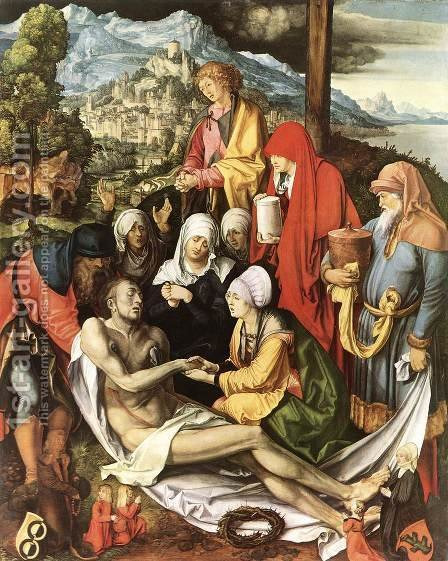Albrecht Durer is one of the greatest German Renaissance painters whose works are admired by both art buffs and tourists in all the top galleries, including the Boston Museum of Art and the National Gallery of Prague. Durer was not only a masterful painter but also equally talented printmaker and engraver.
Born on 21st of May 1471 to an artisan family, Durer had specialized in goldsmithing and printmaking at his young age under the supervision of his godfather, Anton Koberger- the most successful publisher in Germany at that time! He was also apprenticed to Michael Wolgemut, best artist in Nuremberg during that period! Having worked with such big talents, it’s no wonder that the artist is referred to as an ‘Outstanding Renaissance Master’ for the creation of Albrecht Durer artworks.
Genius Shows from a Young Age

Durer was a prodigy! At a tender age he started learning goldsmithing and drawing from his father, who initially wanted him in the family business. During this training, his father had an epiphany and realized that Durer had a great aptitude for drawing. In order to hone his innate talent, he was sent to apprentice under Michael Wolgemut.
After his first apprentice he had gone awol for four years- a period known as Wanderjahre! This was a tradition during the Renaissance period when the aspiring artisans first apprenticed under a master, then spend four years conducting Wanderjahre (gap years) to learn skills from artists around Europe. While there’s no concrete evidence of his whereabouts in the gap year, his travel to Colmar, Frankfurt and Netherlands have been recorded.
An Unhappy Marriage, and the Italian Affair

Soon after his return to Nuremberg he was married to Agnes Frey, the daughter of a prominent brass worker of Nuremberg! Documentation that has survived, including letters and journals have detailed the marriage as a generally unhappy one.
Due to this and various other factors, Durer left for Italy just three months after his marriage. He travelled to Venice with the aim of mastering the advanced world of art. Little was he aware that his stay in Venice would greatly influence the later works Albrecht Durer Adam and Eve and Young Hare I.

During his time in Italy, journaled extensively by Durer himself, he met and learned from a variety of masters during that time, including the eminent artists like Antonio Pollaiuolo and Giovanni Bellini. It was during his time in Italy when he perfected the application of watercolors in art. Prior to achieving this excellence, he relied extensively on silverpoint and woodcarvings.
This period in Italy is also credited with Durer starting to insert symbolism (some religious, some secular) in his art. Melencolia, an engraving he crafted after his return from Italy, was heavy with symbolism popular in Venice during that time and is still extensively discussed in the classes of art interpretation.
Post-Italian years

Durer’s return to Nuremberg in 1495 marked another milestone in her professional life where he established his own workshop. Despite not having the best personal life at home, this period is arguably when Durer created his best works.
Moreover, his natural talent, combined with his understanding of art interpretation and symbolism from Italy helped him reach the pinnacle of artistry in Germany. Young Hare I, one of his surviving art pieces of this period is an excellent example of this.
That’s not all! After his return from Italy, Durer had the ability to mix watercolors, body color, and focus on lighting extensively. In fact, Durer’s theories on ray tracing (following the light as it moves across an object) is still used in graphical rendering software today.
Along with new techniques, Durer also started incorporating symbolism into his work. Adam and Eve, a painting he did during this time is rife with it. Although it depicts the biblical scene of the “fall of man”, Durer’s body proportions follow what was considered ‘ideal’ during the Grecian period. In a move that shows a bit of ego (not uncommon in Renaissance artists), he also depicts Adam holding up a sign that says “Albrecht Durer of Nuremberg” boldly within the painting itself.

Return to Italy
Although a native to Nuremberg, Durer returned to the rich art movement of Venice in 1505. Durer was a close follower and admirer of Bellini, who was one of the earliest Renaissance painters in Venice. His works during and after this time shows a more pronounced Italian influence.
Durer also used to follow Grecian standards for body proportions, but his art from this period reflects the softer tone and shape favored by Italian artists of the period. His work also diversified and evolved which is evident in his painting like ‘Adoration of the Trinity’ that illustrates a crowd scene.

Back to Nuremberg

After his second trip to Italy, Durer returned to Nuremberg where he truly started to flourish as an artisan and created ‘Nuremberg Chronicle’. Did you know that Durer never actually carved his engravings? He would draw on the wood and let skilled craftsmen do the actual carving.
Why you may ask? The answer: he had apprenticed under a block carver and clearly understood the potential of the chisel. While he did give direction to them, he acknowledged that they were better carvers than him. Also, Nuremberg Chronicle is quite a famous work of this amazing painter.
Death and Legacy
Albrecht Durer passed away at the age of 56 from an unidentified illness he contracted on the way back from his last visit to the Netherlands. Due to his illness, he was relatively quiet during his final years and focused more on theoretical works.
Durer focused on human proportions, geometry, and perspectives, creating theories that are being studied to this day. After his death, his works and journals were preserved. He was one of the few artists who kept a detailed journal, which is why so much is known about his life and works like Albrecht Durer Adam and Eve.
